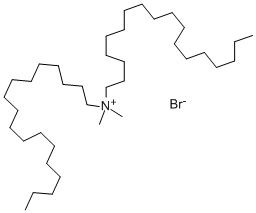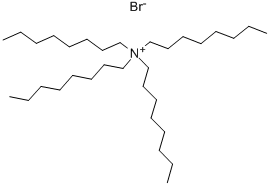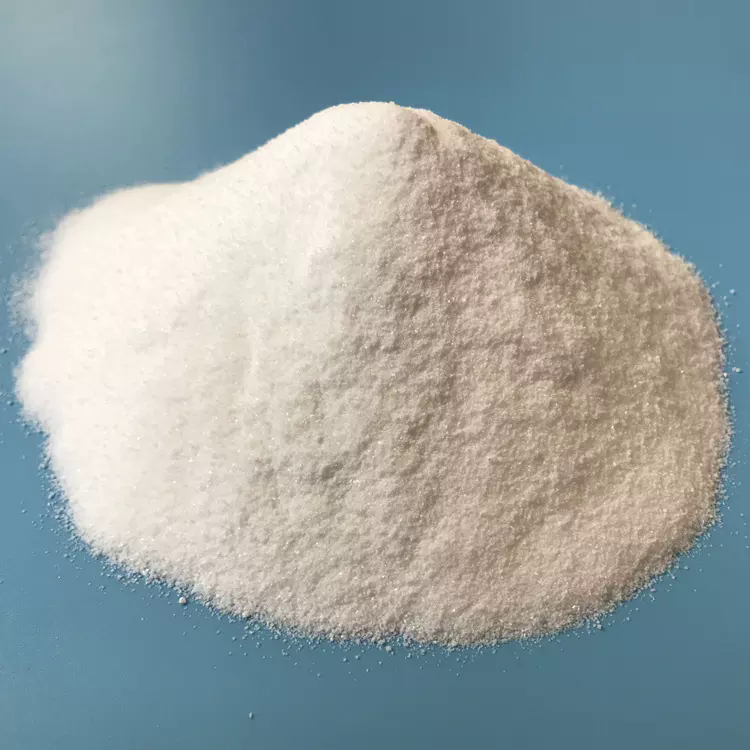(N-HEXYL)TRIMETHYLAMMONIUM BROMIDE
Synonym(s):N,N,N-Trimethylhexylammonium bromide
- CAS NO.:2650-53-5
- Empirical Formula: C9H22BrN
- Molecular Weight: 224.18
- MDL number: MFCD00051872
- EINECS: 629-299-1
- SAFETY DATA SHEET (SDS)
- Update Date: 2023-04-23 13:52:06

What is (N-HEXYL)TRIMETHYLAMMONIUM BROMIDE?
Chemical properties
white solid
The Uses of (N-HEXYL)TRIMETHYLAMMONIUM BROMIDE
Hexyltrimethylammonium bromide (HTAB) can be used as:
- A phase transfer catalyst to synthesize polyether via polycondensation of α, α′-dichloro-p-xylene with 2,2-bis(4-hydroxyphenyl)propane.
- A reagent in the preparation of ZSM-5 zeolites to tune ZSM-5 particles with a scroll-like shape and hierarchical pores.
- A surface-active agent to create the hydrophobic environment around metal nanoparticles (MNPs) even in water. This technique is highly suitable for using MNPs as electron-counting components in biosensors.
What are the applications of Application
Hexyltrimethylammonium bromide is a useful phase transfer catalyst
Purification Methods
Recrystallise it from acetone. It is extremely hygroscopic. [McDowell and Kraus J Am Chem Soc 73 2170 1951, Beilstein 4 IV 710.]
Properties of (N-HEXYL)TRIMETHYLAMMONIUM BROMIDE
| Melting point: | 182-184°C |
| storage temp. | Sealed in dry,Room Temperature |
| form | powder to crystal |
| color | White to Almost white |
| Water Solubility | almost transparency |
| Sensitive | Hygroscopic |
| BRN | 3913229 |
| Stability: | Stable. Combustible. Incompatible with strong oxidizing agents. Avoid exposure to moisture. |
Safety information for (N-HEXYL)TRIMETHYLAMMONIUM BROMIDE
| Signal word | Warning |
| Pictogram(s) |
 Exclamation Mark Irritant GHS07 |
| GHS Hazard Statements |
H315:Skin corrosion/irritation H319:Serious eye damage/eye irritation H335:Specific target organ toxicity, single exposure;Respiratory tract irritation |
| Precautionary Statement Codes |
P261:Avoid breathing dust/fume/gas/mist/vapours/spray. P264:Wash hands thoroughly after handling. P264:Wash skin thouroughly after handling. P271:Use only outdoors or in a well-ventilated area. P280:Wear protective gloves/protective clothing/eye protection/face protection. P302+P352:IF ON SKIN: wash with plenty of soap and water. P305+P351+P338:IF IN EYES: Rinse cautiously with water for several minutes. Remove contact lenses, if present and easy to do. Continuerinsing. |
Computed Descriptors for (N-HEXYL)TRIMETHYLAMMONIUM BROMIDE
New Products
Tert-butyl bis(2-chloroethyl)carbamate 4-Methylphenylacetic acid N-Boc-D-alaninol N-BOC-D/L-ALANINOL N-octanoyl benzotriazole 3-Morpholino-1-(4-nitrophenyl)-5,6-dihydropyridin- 2(1H)-one Furan-2,5-Dicarboxylic Acid DIETHYL AMINOMALONATE HYDROCHLORIDE 1,1’-CARBONYLDIIMIDAZOLE R-2-BENZYLOXY PROPIONIC ACID 1,1’-CARBONYLDI (1,2-4 TRIAZOLE) N-METHYL INDAZOLE-3-CARBOXYLIC ACID (2-Hydroxyphenyl)acetonitrile 4-Bromopyrazole 5-BROMO-2CYANO PYRIDINE 5,6-Dimethoxyindanone 5-broMo-2-chloro-N-cyclopentylpyriMidin-4-aMine 2-(Cyanocyclohexyl)acetic acid 4-methoxy-3,5-dinitropyridine 1-(4-(aminomethyl)benzyl)urea hydrochloride 2-aminopropyl benzoate hydrochloride diethyl 2-(2-((tertbutoxycarbonyl)amino) ethyl)malonate tert-butyl 4- (ureidomethyl)benzylcarbamate Ethyl-2-chloro((4-methoxyphenyl)hydrazono)acetateRelated products of tetrahydrofuran








You may like
-
 Hexyltrimethylammonium Bromide CAS 2650-53-5View Details
Hexyltrimethylammonium Bromide CAS 2650-53-5View Details
2650-53-5 -
 Hexyltrimethylammonium bromide 95% CAS 2650-53-5View Details
Hexyltrimethylammonium bromide 95% CAS 2650-53-5View Details
2650-53-5 -
 Hexyltrimethylammonium bromide CAS 2650-53-5View Details
Hexyltrimethylammonium bromide CAS 2650-53-5View Details
2650-53-5 -
 (1-Hexyl)trimethylammonium bromide CAS 2650-53-5View Details
(1-Hexyl)trimethylammonium bromide CAS 2650-53-5View Details
2650-53-5 -
 Hexyltrimethylammonium bromide, 98% CAS 2650-53-5View Details
Hexyltrimethylammonium bromide, 98% CAS 2650-53-5View Details
2650-53-5 -
 Hexyltrimethylammonium bromide CAS 2650-53-5View Details
Hexyltrimethylammonium bromide CAS 2650-53-5View Details
2650-53-5 -
 2650-53-5 99%View Details
2650-53-5 99%View Details
2650-53-5 -
 733039-20-8 5-broMo-2-chloro-N-cyclopentylpyriMidin-4-aMine 98+View Details
733039-20-8 5-broMo-2-chloro-N-cyclopentylpyriMidin-4-aMine 98+View Details
733039-20-8
Statement: All products displayed on this website are only used for non medical purposes such as industrial applications or scientific research, and cannot be used for clinical diagnosis or treatment of humans or animals. They are not medicinal or edible.